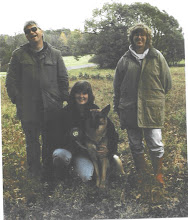 In this sport, to reach your team's full potential you must keep records, and the record you keep in tracking is a map. The first key concept? That two points are required to define a line.
In this sport, to reach your team's full potential you must keep records, and the record you keep in tracking is a map. The first key concept? That two points are required to define a line.TWO points.
TWO stationary points. Learned this the hard way when, years ago, I used a parked car as a line up point. It did not stay parked.
TWO stationary points that are a good distance apart. The bigger the distance apart, the better the definition of your track. (The pix above are pretty close together, but you can still see how it is both obvious when they are lined up and when they are not.) Next time you're walking along, pick two things ahead of you and line up so one thing is in front of the other. I frequently use street lights, signage, trees, tufts of grass etc. Now, walk toward the object closest to you, the one in front. Take a big step to one side. Now the objects aren't lined up anymore, correct? That is how you know you are off the track. But there is more...
TWO stationary points that are a good distance apart and that are in front of you. Having now taught a few seminars and many students, I have found this to be a common newbie mistake. They pick a point in front of and one behind them, thinking that this way they will walk along the line. Nope. The two points must in in front so you can line them up properly.
TWO stationary points that are a good distance apart and that are in front of you that are unique. Ooo, this one is a toughy, at least for me. I get so focused on laying my track that I line up a distant tree with that fabulous bunch of Queen Anne's Lace. Perfect! Only to realize when I get to the start flag with my dog that the field is FILLED with Queen Anne's Lace!
Drat!
So now you have a basic but fundamental principle of tracking under your belt - that when making a map of your track, you need two stationary, unique points in front of you that you can line up. Sounds easy enough, yes?
In theory.
You might want to start off with making some maps of tracks - leaving articles behind and then returning later to refind everything without your dog. This allows you to learn without risking any canine confusion.
Getting this worked out will make you a better coach for your dog and you will move forward with more confidence and clarity. Go track!







Very helpful! And yes, that unique part... I need to remember that one-- I'm really good at lining up tufts of grass, as if a field doesn't have thousands of tufts of grass. I'll keep this in mind next time I'm looking for points.
ReplyDelete